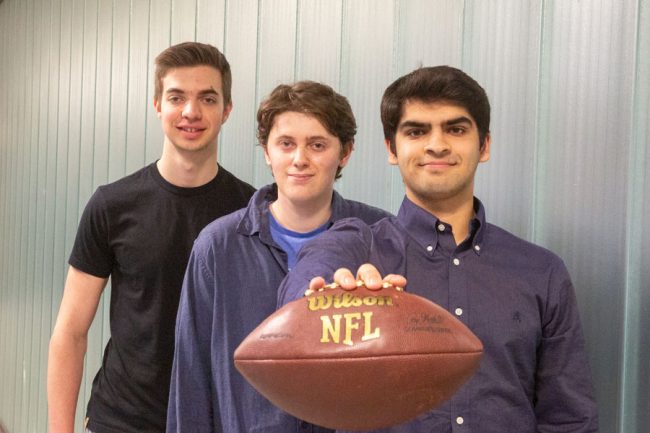
By Tyler Irving
On Sunday, a group of U of T students will join an estimated 100 million people in experiencing Super Bowl LVII — but they’ll be watching the game with a different perspective than most other fans.
Last week, Hassaan Inayatali (Year 3 EngSci), Aaron White (Year 2 Statistical Science) and Daniel Hocevar (Year 3 Computer Science) learned that they are finalists in the National Football League’s Big Data Bowl, one of the largest sports analytics competitions in the world.
Together, they developed a statistical model that transforms data derived from motion-tracking chips embedded in the players’ uniforms into animated heat maps.
Their colourful visualizations provide real-time analysis of the all-important pocket of space around the quarterback, including the amount of pressure it is under at any given moment and how long it is likely to last.

“Our tool provides a quantitative way to compare plays and answer the really critical questions that players and coaches have,” says Inayatali.
“For example: which offensive lines are the best at protecting their quarterback? Which defensive lines are best at rushing the other team’s quarterback? And which individual players are having the biggest impact?”
Like his teammates, Inayatali was a big sports fan growing up. Although his favourites were baseball and hockey, he was more than willing to watch any game he had the chance to see.
But the concept of sports analytics wasn’t really on his radar until he attended the Fall Clubs Fair in his first year as an undergraduate. That’s where he learned about University of Toronto Sports Analytics Student Group (UTSPAN).
“I was lucky enough to go to their very first meeting, and kind of fell in love with what they were doing,” he says.
“It’s an opportunity to apply all the coding and mathematics I’ve been learning as part of my Engineering Science degree to sports, which has always been one of my passions.”
Today, Inayatali, White and Hocevar are all on the leadership team for UTSPAN, which is advised by Professor Timothy Chan (MIE). The group holds weekly meetings, welcome to any experience level, covering different topics in sports analytics.
They also post regularly on Kaggle, an online hub for the sports analytics community, which hosts open-source code, public datasets and notices about big data competitions.
It was there that the team first heard about the Big Data Bowl, which ran for the first time in 2019. The competition challenges students and professionals alike to contribute to the NFL’s continuing evolution of the use of advanced analytics.
Early in the fall of 2022, the three students decided that they would enter this year’s competition. They were supplied with eight weeks of data from the beginning of the NFL’s 2021 season. The package included play-by-play data, such as scores and number of completed passes, as well as scouting data, such as whether a player was hit, sacked or hurried.
But most importantly for the team’s purposes, it also included detailed player tracking data, derived from a system of sensors and RFID tags embedded in the players’ uniforms.
“Basically, what you get is a spreadsheet that shows each player’s x and y position on the field, down to an accuracy of two decimal places, so one one-hundredth of a yard,” says White. “And this position is updated ten times per second.”
The team then combed through the published scientific literature on sports analytics, looking for examples of how to turn this data into useful insights. In the end, their inspiration came not from the world of football, but from the world of soccer, in the form of a paper published by researchers from Simon Fraser University and F.C. Barcelona in 2018.
“That work focused on modelling the spaces between players and determining which ones are most valuable,” says Inayatali.
“So that’s the basis for how we modelled the pocket, but then we layered on two more concepts. The first is pocket pressure, which is an indication for how much control each team has over the space at a given moment. The second is pocket longevity, or how long the pocket is likely to last.
“These concepts previously existed, but nobody had brought them together like this before.”
The team created a notebook in Kaggle that outlined their approach via a series of diagrams and sample codes, then submitted it to the NFL in early January. Weeks of tense silence followed, but soon the team heard that the results would be announced at 11 a.m. on February 1.
“I was actually at the dentist at that moment, and I was frantically refreshing the web page on my phone,” says White. “When I found out that we made the finals, I showed it to the dentist. They had no idea what it was all about, but they said congratulations all the same.”
The team is one of only eight selected to participate in the finals — and one of only two composed of undergraduate students — from a field of more than 300 entries. Their winning entry earned them a $10,000 prize, and an all-expenses-paid trip to attend the 2023 NFL Combine in Indianapolis, in early March.
There, they will have four minutes to present their project to more than 200 football professionals. If successful, they will win a further $20,000, and a chance to be a part of NFL history.
“In the past, winners of the Big Data Bowl often become sports analytics professionals working for major teams,” says White.
“The two teams in this year’s Super Bowl, the Kansas City Chiefs and the Philadelphia Eagles, each have one winner of the 2021 Big Data Bowl working for them. That would really be a dream come true.”
This article was originally published in the U of T Engineering News.